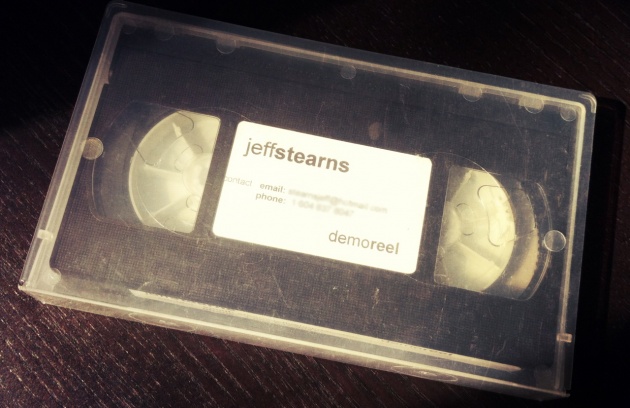
As the owner of a small boutique animation production company, Meditating Bunny Studio Inc., I receive a steady stream of emails from young animators looking for work. So needless to say, I watch my fair share of demo reels. A demo reel is a sampling of a collection of work by an animator, 3D modeler, director, cinematographer, etc. that includes small clips, exercises, and highlights of longer projects strung together to help demonstrate the range and talent of an artist.
I can remember back to my time at the Emily Carr University of Art and Design in 2001 when I was graduating from the animation program. Putting together my demo reel was the most important aspect of going through those four years of animation school since this little reel had to be good enough to land me animation work so I could pay off all those student loans. Back in 2001, we still used bulky VHS tapes that we had to mail off to studios with hard copy cover letters. Although, now 12 years later, I’m happy to see that things have gotten a lot easier and more efficient with the advancement of the all mighty interweb!
Because I watch a lot of reels and have had to create reels for my studio, I thought it would be nice to write a blog post on some advice I can give animation and film students about constructing a great demo reel.
First off, start with a title, usually your name and your artistic specialty. If you’re an animator (classical, Flash, stop motion, CGI), 3D modeler, video game concept artist, cinematographer or director, make sure to specify that in the beginning so we can judge you on these skills. You may have to cut a few different reels that highlight each skill depending on the specific job or studio. For example if you are applying for an animation position using Flash, include more Flash animation in your reel. But if the studio is looking for CGI animators, cater the reel to include more CGI created animations. With that being said, I also look for a strong level of animation knowledge using any technique or medium especially classical hand drawn animation.
If you’re creating a director or cinematography reel, try to highlight how you work with actors and include some amazing shot compositions using a variety of lens and cameras to showcase your skills. If you’re an animator, I’ll be looking at how you capture the illusion of life and how you creatively approach the art form of animation. As well, I look for strong drawing ability, individual style, and mastery of animation techniques and imagination.
When I watch a demo reel, I can tell in the first 30 seconds if an animator has creativity and talent. It will show right away. Therefore, always put your best work at the beginning to wow the viewer. Since I’m super busy, I will normally give each demo reel at least 30 seconds. If I’m impressed in those 30 seconds, I’ll usually watch the entire reel. A good rule of thumb is to keep the reel less than 2 minutes in length. This is a classical example of less is more. A good reel should be between 1 and 2 minutes long. If you have limited content, put the best work at the beginning, good work in the middle and end strong with some more of your best work. That way the viewer ends with a sense that they’ve watched an entire reel of great material.
Today, most animators and film students have reels on their websites or on another online video sharing platform that they can easily share in an email. Thus, when applying for a job to a company/studio make sure to include a link to your reel in the introductory email or cover letter. Also, if the studio likes your reel, they'll want to see a bit more. So it's a good idea to also include an online link to a full short film you created so they can get a sense of how you complete a finished piece of work to better understand your direction, storytelling, and aesthetic.
Although before you launch your demo reel into the world, made sure you have your friends, peers, and instructors watch it first. Get their feedback and make adjustments based on their critique. Often times you can get so connected to your work that it’s hard for you to decipher really what is good, mediocre or even bad. Also, you should post some early cuts of your reel online and ask people to comment on it. You can also use Facebook and ask animation friends some advice about what they think makes a good reel.
It’s also a great idea to watch your reel in a group with a few people who you don’t know. If you get a bad or weird feeling about something or you feel embarrassed by something in the reel when it pops on the screen, take it out. If you feel blood rushing into your cheeks in embarrassment, that probably means that you should probably take it out because it may not be as good as you originally thought. You should never feel embarrassed about anything you include in your reel.
As well, if you know some professional animators or film industry folk, have them watch it to offer critiques. A reel doesn’t have to be flashy but should be edited well. I personally like to show a wide range of the work I do, highlighting various techniques and skills. It also helps to pick music that compliments your work and cut the footage to the beat. Cutting to the beat helps created an upbeat and well paced reel. I would also recommend using shorter clips as opposed to long clips to keep the viewers attention span and offer a nice range of material.
For a demo reel, because it is promotion, you can use licensed music. But if you are going to put the reel online publically (not password protected), I would recommend crediting the band or musician/composer or finding some royalty free music to use. I have some composer friends who were happy to have me feature their work in my reels. In my demo reel below, my buddy Scott Rankin who did the music for my film “What Are You Anyways?” supplied me with some beats for my studio reel. Also, I know some people really like Kevin MacLeod’s instrumental arrangements. He offers tons of royalty free music on his website which you can find here: http://incompetech.com/music/royalty-free
Also, always make sure to include your contact info at the end of the reel. Normally an email address is best because chances are your phone number will change at some point and email addresses usually stay constant. Also, always make sure to check your spam folders since most companies have unique email addresses that sometimes they end up in the spam folder. It would be a shame to miss a job opportunity due to some crappy spam filter.
If you have any questions or any advice on demo reels of your own, please leave a comment below and please subscribe for updates on new blog posts. Also please pass this on to any animation/film students you think could benefit from this post. Feel free to message me if you would like to show me your reel and would like a brief critique. My next blog series will be on how to use film festivals to market, promote, and sell your work.
Here’s my 2012 studio reel for Meditating Bunny Studio Inc. It is a reel made up of independent films and commercials we’ve created at the studio over the last 12 years. Sorry for some reason the clip is squished when it was uploaded, it should be full 16x9.



